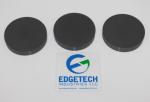Properties of Silicon Nitride Ceramics
by Izzy X. Product specialist There are two types of silicon nitride (SI3N4), both of which belong to the hexagonal crystal system. Both are three-dimensional spatial networks composed of tetrahedrons sharing vertices. There is on
Recommended Features
There are two types of silicon nitride (SI3N4), both of which belong to the hexagonal crystal system. Both are three-dimensional spatial networks composed of tetrahedrons sharing vertices. There is on
Recommended Features
- Silicon nitride ceramics sintered at high temperature are composed of polycrystals aggregated by many crystallites.
- Ceramic materials are a combination of polycrystals. The junctions between grains of the same composition with different crystallographic directions are called grain boundaries
- It is a reasonable way to improve the fracture energy and impact toughness of raw materials. It is also beneficial to have appropriate micro-cracks in porcelain components to resist thermal shock dama
- Silicon nitride is a covalent compound, so atoms are bonded to each other with strong covalent bonds, so it has high hardness and melting point.
- Silicon nitride has excellent chemical properties and is resistant to corrosion by all inorganic acids except hydrofluoric acid and sodium hydroxide solution below 25%.
Review on Properties of Silicon Nitride Ceramics
Silicon nitride special ceramic materials also have a glass phase. Due to the formation of a liquid phase during the sintering process, it can reduce the sintering temperature, prevent polycrystalline transformation, inhibit grain growth and promote grain bonding. Silicon nitride ceramic molten salt corrosion, generally called molten inorganic compound as molten salt, is an ionic melt composed of cations and anions, and has many characteristics that aqueous solutions do not have. Molten salt is an ionic melt with a wide temperature range, large heat capacity and stable chemical properties. It can be widely used in molten salt electrolysis for gold production. However, high temperature molten salt is highly corrosive, and even very stable ceramic materials are easy to use. corroded. In the process of preparing metal aluminum by molten salt electrolysis, ceramic materials, generally silicon nitride or silicon carbide materials, are often used as the inner wall of the reaction vessel, so the corrosion of cryolite molten salt to ceramics has also attracted attention. Silicon nitride ceramics are chemically stable and resistant to corrosion. They do not react with other inorganic acids except hydrofluoric acid. They do not react with oxygen in a dry atmosphere of 800 C. When the temperature exceeds 800 C, a silicon oxide film begins to form on the surface. The silicon oxide film gradually becomes stable as the temperature rises, and a dense silicon oxide film can be formed with oxygen at about 1000C, which can be kept stable until 1400C. Silicon nitride and water have almost no effect; slow hydrolysis reaction in concentrated strong alkali aqueous solution converts into ammonia salt and silicon dioxide; soluble in hydrochloric acid, and dilute alkali failure concentrated strong acid aqueous solution can slowly erode silicon nitride, melting Strong acids can rapidly change silicon nitride to aluminosilicates and ammonia. There are many types of silicon nitride ceramiRelated to Properties of Silicon Nitride Ceramics
Related Articles
Silicon powder applied in silicon nitride ceramics production
Because the high melting point of silicon nitride ceramics, for metal and the oxide melt have considerable high temperature stability, increasingly used in various fields of thermal, such as cerami...Sponsor Ads
Created on May 8th 2024 22:37. Viewed 30 times.
Comments
No comment, be the first to comment.




